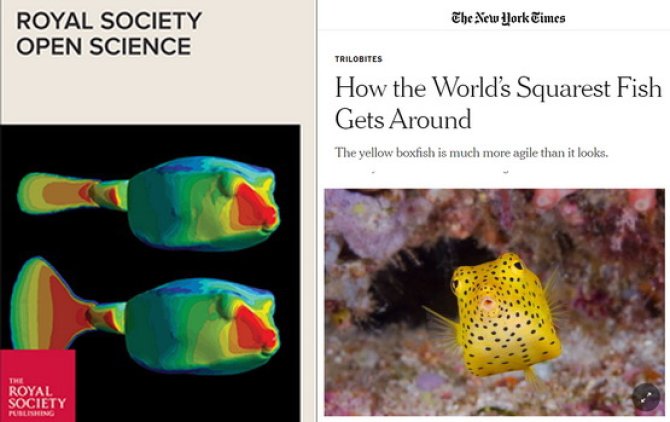
News
The New York Times highlights boxfish research
Boxfishes (Ostraciidae) are a fascinating group of fishes, which have stirred up scientific debates for years. Because how do these funny and weird looking fishes remain course-stable during swimming? Recent findings by Pim Boute et al. published in Royal Society Open Science show that the caudal fin of the yellow boxfish (Ostracion cubicus) is crucial for yaw control, hence enable the animal to course-stabilise or steer.
The body of boxfishes is inherently unstable in yaw, preventing course-stabilisation of the animal during swimming. The boxfishes’ body is encased in a so-called carapace (a kind of body armour), that precludes body undulation. Hence, swimming movements can only be generated by the fins, which protrude from the carapace. Boute et al. studied how the yellow boxfish is able to gain yaw control with the caudal fin. By using 3D printed models in a flow tank and computer simulations of the yellow boxfish, Boute et al. quantitatively show that the caudal fin is crucial for yaw control. The yellow boxfish uses its caudal fin as a rudder by adjusting yaw torque through closing or opening, and turning this fin with respect to the body. These findings match with ecological theories that controlled instability is favourable to increase manoeuvrability. This knowledge on yellow boxfish swimming can be used to, for example, design underwater robots. The study is featured on the cover of this Royal Society Open Science issue. Read the publication here.

The New York Times noticed the study and interviewed Pim Boute about their findings.
Read the article in The New York Times
Pim Boute conducted this work during his master’s at the Department of Ocean Ecosystems of the University of Groningen under direct supervision of Eize Stamhuis. This study was part of a longer running research project which was initiated by the University of Groningen and performed in collaboration with Sam Van Wassenbergh of the University of Antwerp. Currently, Pim Boute is a PhD candidate at the Experimental Zoology Group.